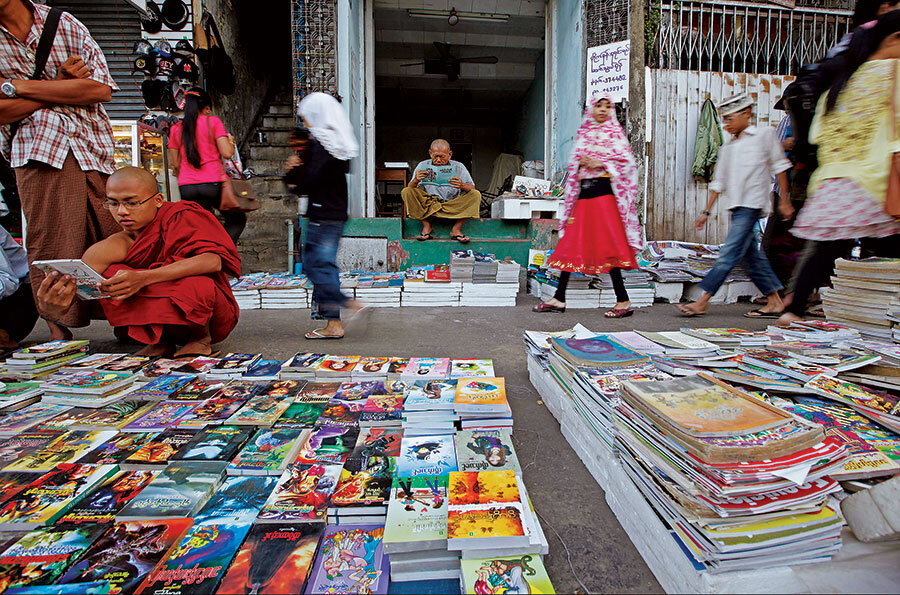The sages of Hsipaw
Loading...
“Look at my treasures!” cried Mr. Book, emptying a bag of insect-damaged paperbacks onto the table. “See, they found Dostoyevsky delicious.” He picked up a copy of “The Brothers Karamazov,” chewed into a misshapen “L” by termites.
We couldn’t blame them – good books are rare in Myanmar (Burma), and even more so in rural Shan State. After two weeks, my husband and I were running out of reading material.
In Yangon and Mandalay we’d browsed bookstalls but, apart from Orwell’s “Burmese Days,” had failed to turn up any books in English. Termite-ridden titles aside, Mr. Book’s stall on the main street of Hsipaw was a library by comparison.
We had arrived here by railway, bouncing past blue-tinged mountains and fields of sunflowers. Like most travelers to this remote town, we planned to depart later that day for a trek to the surrounding tribal villages, where farmers tilled electric-green rice terraces. Instead, we found ourselves sitting down to a pot of grainy black coffee behind Mr. Book’s shop.
“Have you read ‘Siddhartha’?” he asked. “Oh, that is a very good book.”
I hadn’t read Hesse since high school and confessed that I remembered little of “Siddhartha.” When I revisited the tale much later, I recalled the stages of Siddhartha’s search for knowledge – and the ferryman who leads him to the source.
Mr. Book pointed to the phrase “Think, Wait, and Fast” scrawled in chalk above his doorway. “I leave the quote unfinished so that people will read the book,” he said, winking through his bifocals.
The next day we left our guesthouse early, planning to squeeze in a hike before catching the daily bus to Inle Lake. On our way through town we stopped at Mr. Book’s stall to say goodbye.
“Hello!” he said. “Are you busy? There’s someone I want you to meet.”
“Um ...” I hesitated, imagining the tribesmen we wouldn’t get to see. I looked at my husband, who was already shoving the trekking map back in his bag. “No, we’re not busy.”
Mr. Book grabbed his walking stick and led us outside, past the mosque with bearded men milling about it and the market with its piles of curry and cheroots. Stopping at a wooden gate, he indicated for us to step inside and said, “This is my teacher’s home. She’s expecting you.”
A nonagenarian in a paisley dress sat in the dark in the stilt house.
“Aren’t you going to sit down?” said a voice in clear, unaccented English. It belonged to the woman, who looked about four feet tall. As our eyes adjusted to the shade, we saw that beside her was a textbook and a boy who had disabilities. She looked us over with steady gray eyes, her face lighting up beneath a thousand tiny wrinkles.
“So,” she laughed good-naturedly, “what do you want to talk about?”
She introduced herself as Sao Myo Cit, a 30-year primary school English teacher, and 30-year retiree on a pension of $1 a month, continuing to teach free of charge.
“If people want broken English, I tell them not to come to me. But if they want to learn the real thing, well, I’m still living,” she said.
While she was speaking, a group of children, faces smeared with yellow thanaka paint, had crept into the yard, clutching shiny packages and giggling.
“Excuse me,” she told us. “I have to bless these kids.” She turned and spoke to them gently, her mouth curved into a childlike half smile. The preschoolers bowed in the grass and handed her chocolates. I felt sudden veneration.
Noticing our faces, she closed her eyes and said, “A Spanish woman was visiting Hsipaw years ago. One morning she brought me flowers she had purchased at the market, and I asked her to join me for breakfast. As we were eating, she jumped up and exclaimed, ‘This place is so full of love!’ ”
She opened her eyes. “I don’t know why she said that. These days the town is so big I can get lost in it.”
Eventually we apologized to her student for interrupting and bid farewell. Mr. Book was waiting to show us to the bus stop. We retraced our steps past the market, where a line of prepubescent nuns in carnation-pink robes was collecting alms. A girl stood at the intersection flinging holy water from a cut tree branch; the droplets hit me in the face and rolled down my cheeks.
At the bus stop, sunburned Frenchmen fanned themselves in the shade. Mr. Book took our hands and beamed.
“Next time you come, we’ll go trekking,” he said.
I laughed. “Next time.”
He turned, and we watched him make his way back toward the town, propelling himself with his staff as if it were an oar in the dust.







